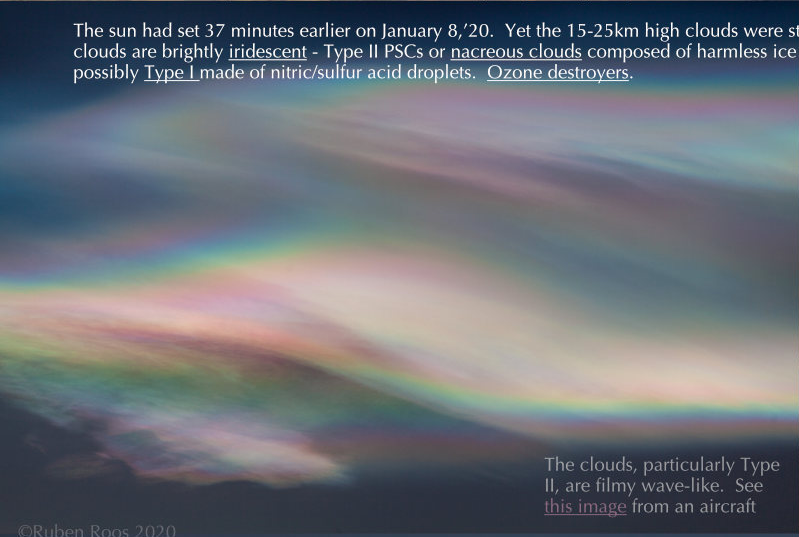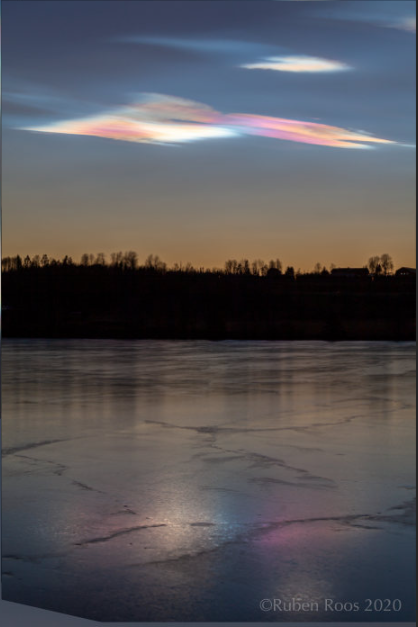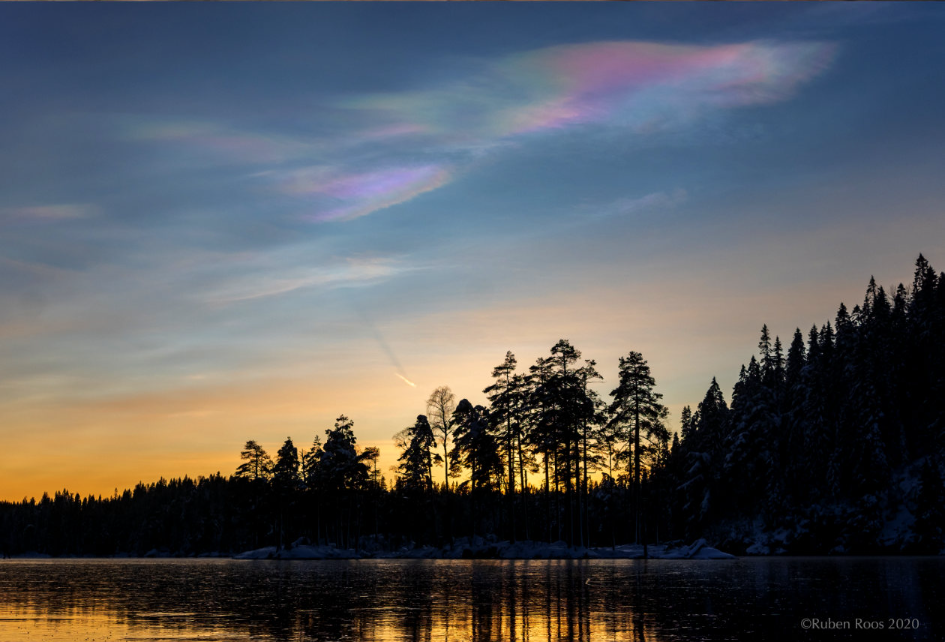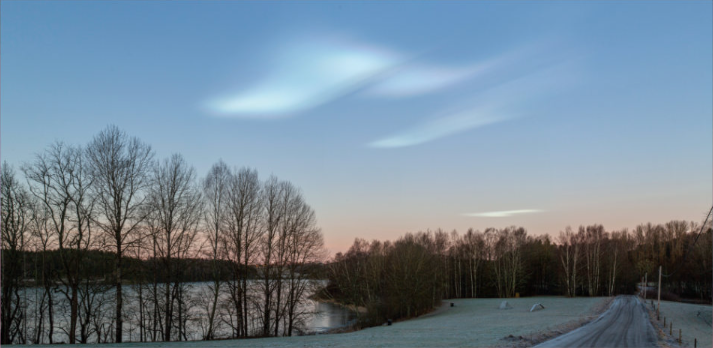PSCs Polar Stratospheric Clouds, Norway
PSCs: Polar Stratospheric Clouds, Norway
Polar Stratospheric Clouds (PSCs) are a mesmerizing atmospheric phenomenon that occurs in the polar regions, including Norway. These unique clouds arch over the twilight sky, creating a captivating display of colors and textures. PSCs are formed in the stratosphere, approximately 15 to 25 kilometers above the Earth's surface. Despite the setting sun, these clouds continue to be illuminated by stratospheric sunlight, painting the sky with their ethereal glow.
Types of PSCs
There are two main types of PSCs that can be observed in Norway's skies: Type I and Type II. Type II PSCs, also known as nacreous clouds, are the most visually striking. These clouds appear brightly iridescent, resembling delicate waves of filmy colors. They are composed of harmless ice crystals and add a touch of enchantment to the already beautiful twilight sky.
On the other hand, Type I PSCs are less iridescent and may appear less visually impressive. These clouds are composed of nitric and sulfuric acid droplets, making them potentially harmful to the environment. In fact, they are known as "ozone destroyers" due to their role in ozone depletion.
The Beauty of PSCs
PSCs are a sight to behold, and their unique characteristics make them a subject of fascination for scientists and sky enthusiasts alike. Here are some additional details that make PSCs even more intriguing:
-
Filmy Wave-like Appearance: PSCs, particularly Type II clouds, have a distinctive wave-like structure. When observed from an aircraft, their delicate and undulating patterns become even more apparent.
-
High Altitude Formation: PSCs form at high altitudes in the stratosphere. This location allows them to catch the remaining sunlight even after sunset, creating a stunning display of colors against the darkening sky.
-
Occurrence in Polar Regions: PSCs are primarily observed in the polar regions, including Norway. The unique atmospheric conditions in these areas, such as low temperatures and stable air masses, contribute to the formation of these captivating clouds.
The Science Behind PSCs
Understanding the science behind PSCs can deepen our appreciation for these atmospheric phenomena. Here are some key factors that contribute to the formation and appearance of PSCs:
-
Stratospheric Sunlight: Despite the setting sun, the stratosphere still receives sunlight due to its high altitude. This illumination is crucial for the vibrant colors and iridescence exhibited by Type II PSCs.
-
Low Temperatures: PSCs require extremely cold temperatures to form. In the polar regions, where temperatures can drop significantly, the conditions are ideal for the formation of these clouds.
-
Chemical Composition: The chemical composition of PSCs plays a vital role in their appearance and environmental impact. While Type II clouds are composed of harmless ice crystals, Type I clouds contain nitric and sulfuric acid droplets, which can contribute to ozone depletion.
Appreciating PSCs Safely
Witnessing the beauty of PSCs in person can be an awe-inspiring experience. However, it is important to prioritize safety when observing these atmospheric phenomena. Here are some tips for safely enjoying PSCs:
-
Use Protective Eyewear: When observing PSCs, especially Type II clouds with their bright iridescence, it is advisable to use protective eyewear to avoid any potential damage to your eyes.
-
Follow Safety Guidelines: If you plan to photograph or document PSCs, make sure to follow safety guidelines and use appropriate equipment. This will help you capture the beauty of these clouds while keeping yourself and others safe.
Conclusion
Polar Stratospheric Clouds (PSCs) are a captivating natural phenomenon that graces the skies of Norway. These clouds, particularly Type II PSCs, create a mesmerizing display of colors and patterns, adding an ethereal touch to the twilight sky. Understanding the science behind PSCs enhances our appreciation for their beauty while also shedding light on their environmental impact. By appreciating PSCs safely and responsibly, we can continue to marvel at the wonders of our atmosphere.

PSCs, Polar Stratospheric Clouds, arch over a twilight sky. Imaged by Ruben Roos near Oslo, Norway.
The sun had set 37 minutes earlier on January 8,'20. Yet the 15-25km high clouds were still bathed in stratospheric sunlight. At left the clouds are brightly iridescent - Type II PSCs or nacreous clouds composed of harmless ice crystals. The less iridescent clouds at right are possibly Type I made of nitric/sulfur acid droplets. Ozone destroyers.

The sun had set 37 minutes earlier on January 8,'20. Yet the 15-25km high clouds were st clouds are brightly iridescent - Type II PSCs or nacreous clouds composed of harmless ice possibly Type I made of nitric/sulfur acid droplets. Ozone destroyers.
Ruben Roos 2020
The clouds, particularly Type II, are filmy wave-like. See this image from an aircraft

The clouds, particularly Type II, are filmy wave-like. See this image from an aircraft.






Note: this article has been automatically converted from the old site and may not appear as intended. You can find the original article here.
Reference Atmospheric Optics
If you use any of the definitions, information, or data presented on Atmospheric Optics, please copy the link or reference below to properly credit us as the reference source. Thank you!
-
<a href="https://atoptics.co.uk/blog/pscs-polar-stratospheric-clouds-norway/">PSCs Polar Stratospheric Clouds, Norway</a>
-
"PSCs Polar Stratospheric Clouds, Norway". Atmospheric Optics. Accessed on December 28, 2024. https://atoptics.co.uk/blog/pscs-polar-stratospheric-clouds-norway/.
-
"PSCs Polar Stratospheric Clouds, Norway". Atmospheric Optics, https://atoptics.co.uk/blog/pscs-polar-stratospheric-clouds-norway/. Accessed 28 December, 2024
-
PSCs Polar Stratospheric Clouds, Norway. Atmospheric Optics. Retrieved from https://atoptics.co.uk/blog/pscs-polar-stratospheric-clouds-norway/.